Influence of Orientation and Radiative Heat Transfer on Aluminum Foams in Buoyancy-Induced Convection
Abstract
:1. Introduction
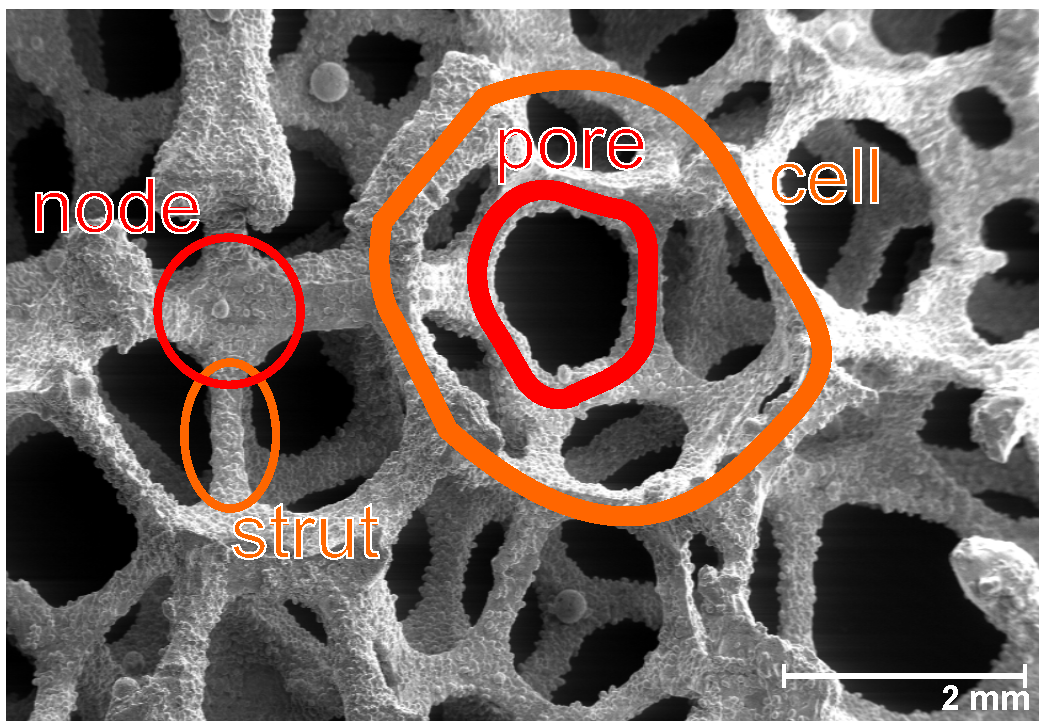
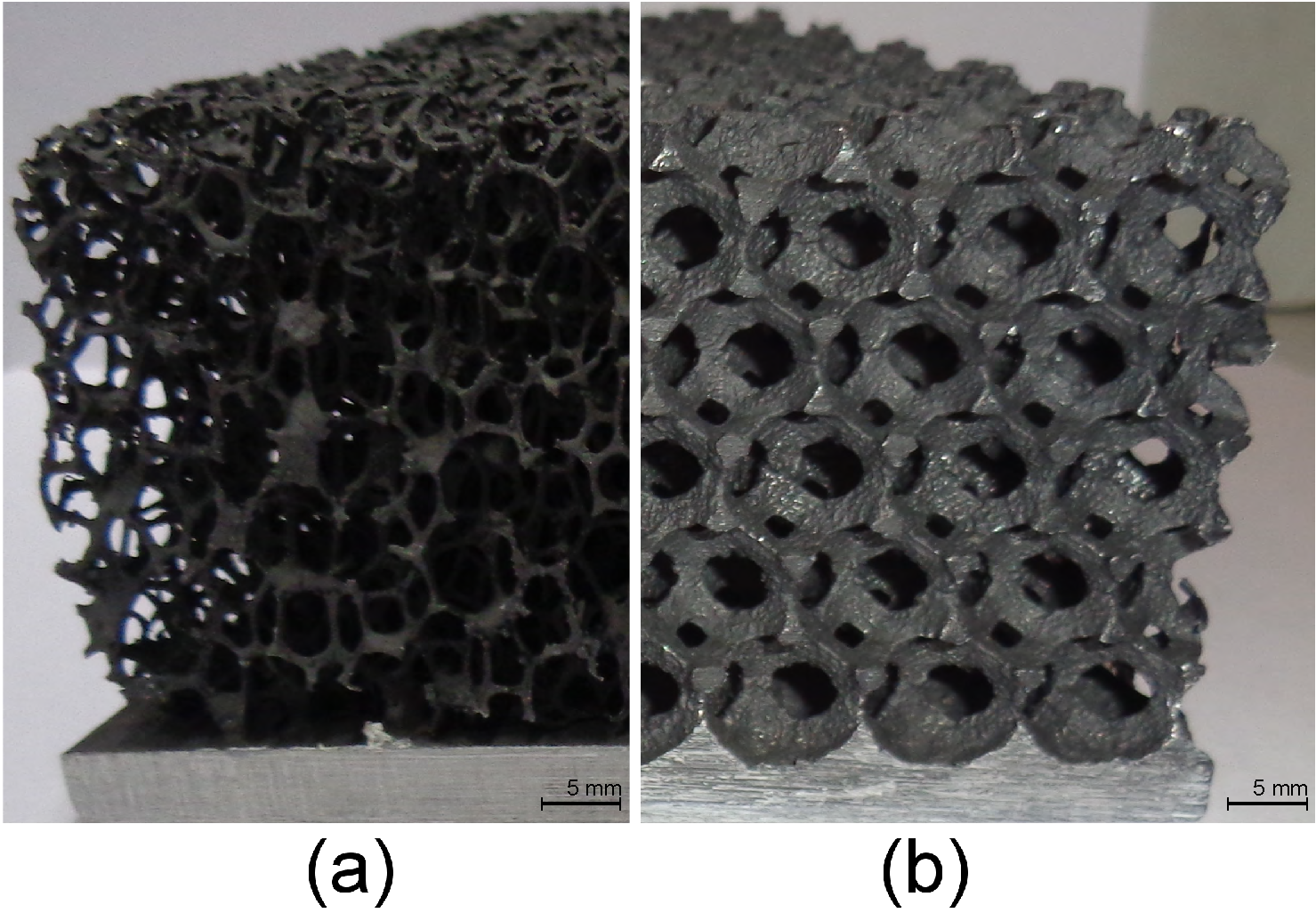
- –
- –
- –
- The heat dissipated by the metal foam heat sink increases with increasing heat sink height until it reaches an asymptotic value. The asymptotic value is reached when the effect of the increasing viscous drag and the temperature drop along the heat sink’s height equals the effect of increasing surface area [20,21];
- –
- De Schampheleire et al. [22] indicated the importance of the radiative heat transfer of metal foam heat sinks in buoyancy-driven convection. The authors found that up to 30% of the total heat transfer of aluminum foam heat sinks in buoyancy-induced convection is due to thermal radiation;
- –
2. Methodology
2.1. Experimental Setup
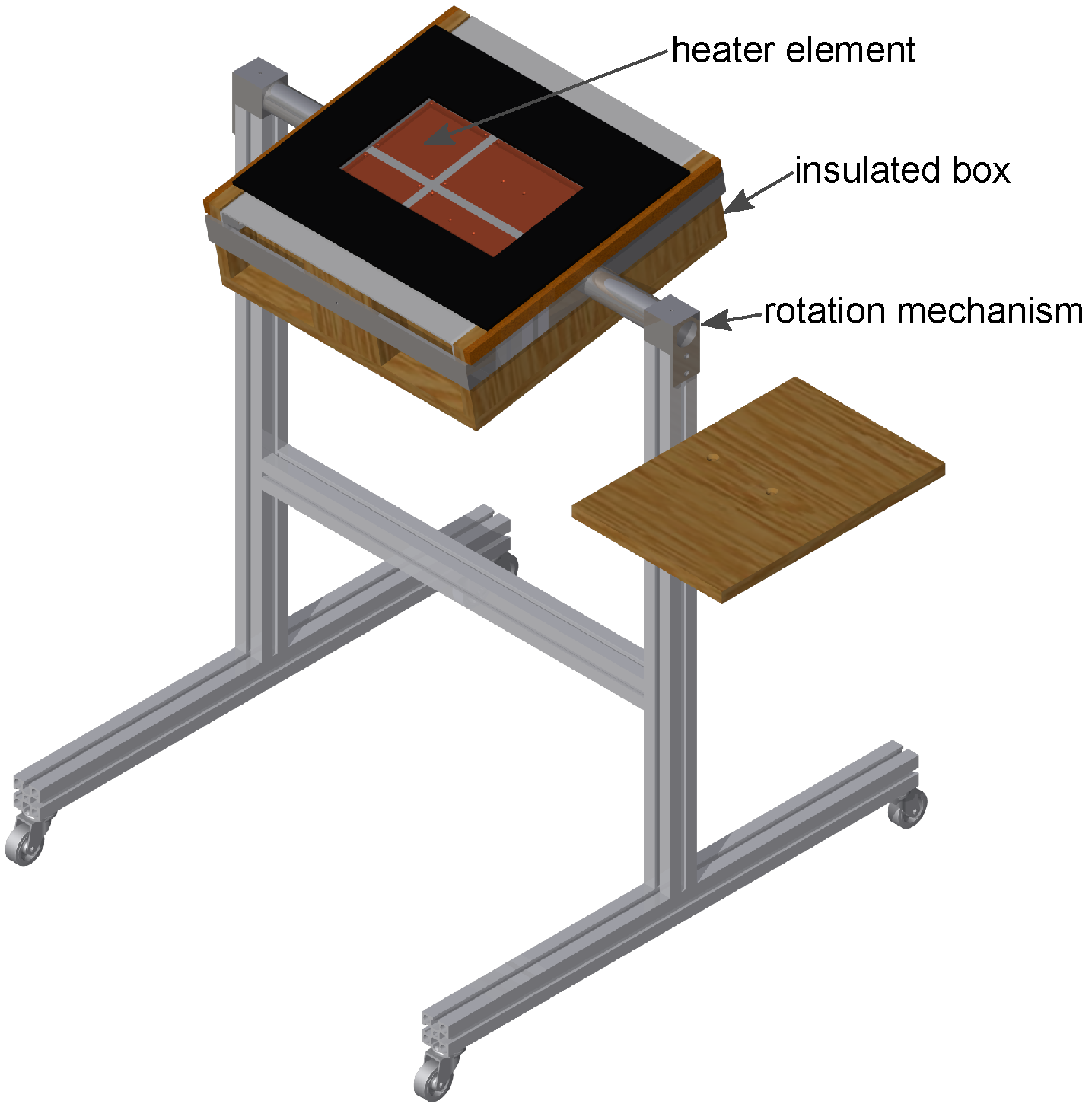
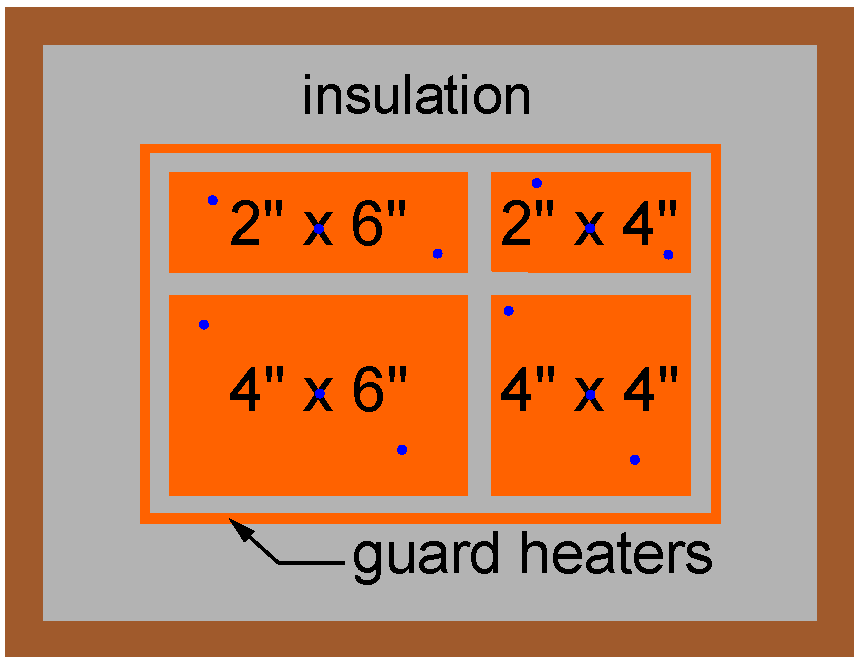

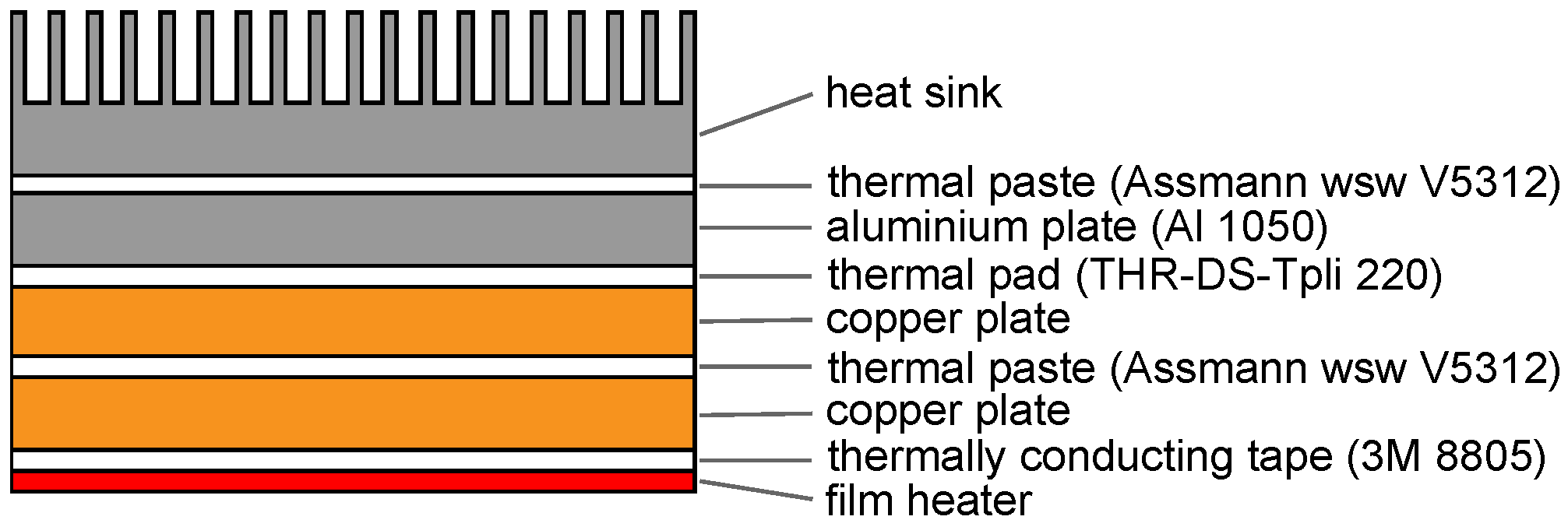
2.2. Test Samples
| Name | Width (mm) | Length (mm) | Height (mm) | # Fins | Porosity (-) | PPI | σ (m/m) | Material |
|---|---|---|---|---|---|---|---|---|
| plate | 150.3 ± 0.05 | 101.4 ± 0.05 | 0 | - | - | - | - | Al 1050 |
| block22 | 150.0 ± 0.05 | 99.0 ± 0.05 | 22.0 ± 0.05 | - | 0 | - | 79 | Al 1050 |
| block40 | 150.0 ± 0.05 | 99.0 ± 0.05 | 40.0 ± 0.05 | - | 0 | - | 59 | Al 1050 |
| reticulated22 | 150.0 ± 0.05 | 100.9 ± 0.05 | 22.2 ± 0.05 | - | 0.946 | 10 | 486 | Al 1050 |
| reticulated40 | 149.3 ± 0.05 | 101.0 ± 0.05 | 40.0 ± 0.05 | - | 0.946 | 10 | 486 | Al 1050 |
| spheres40 [25] | 149.8 ± 0.05 | 97.5 ± 0.05 | 40.0 ± 0.05 | - | 0.85 | 2.5 | 360 | Al 1050 |
| finned22 [27] | 150.0 ± 0.05 | 101.0 ± 0.05 | 22.0 ± 0.05 | 25 | 0.65 | - | 352 | Al 6060 |
2.3. Measuring Procedure
2.4. Uncertainty Analysis
3. Results and Discussion
3.1. Comparison to Commercial Finned Heat Sink
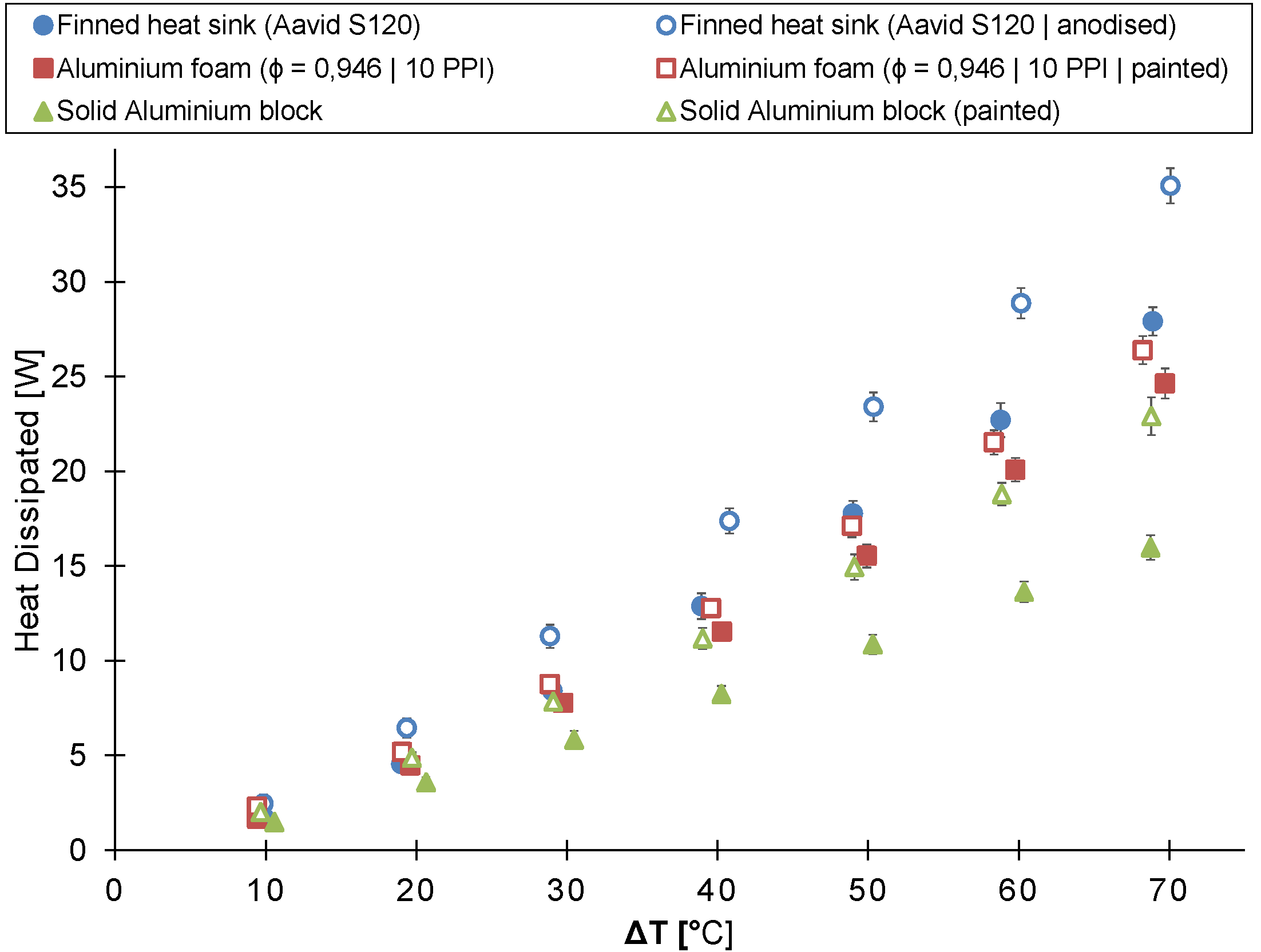
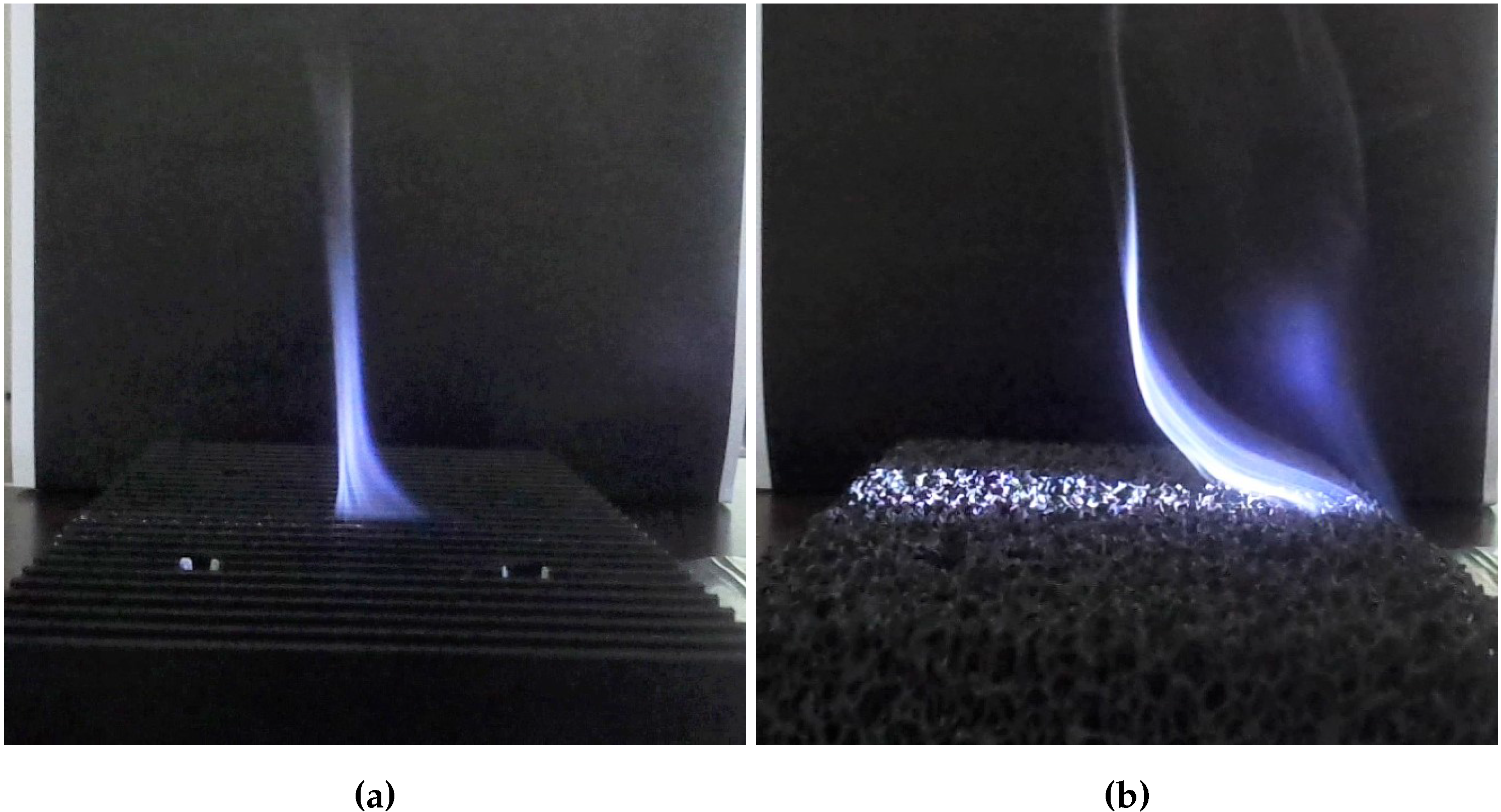
3.2. Comparison between the Alveotec® and the In-House-Made Aluminum Foam
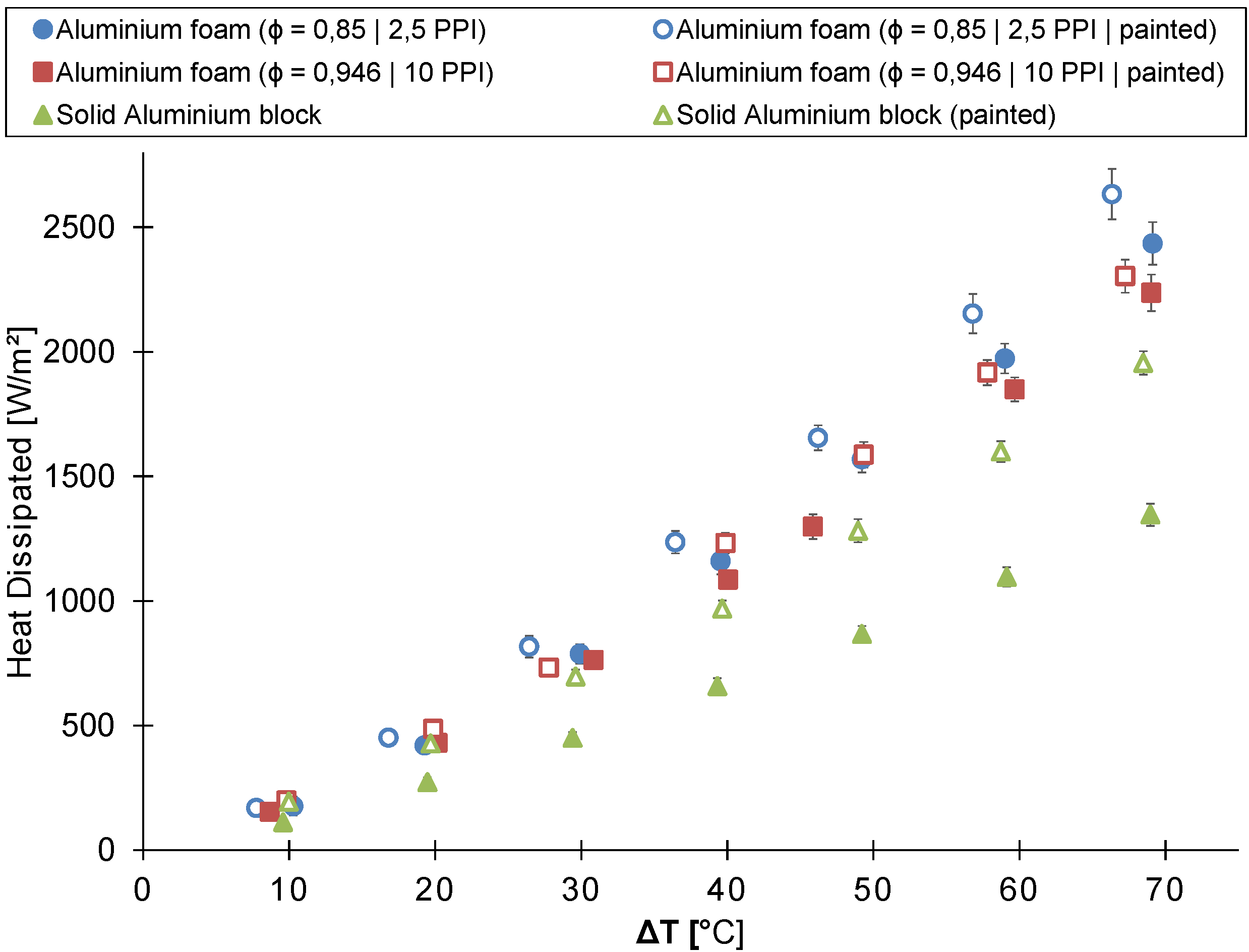
3.3. Radiative Heat Transfer
3.4. Orientation
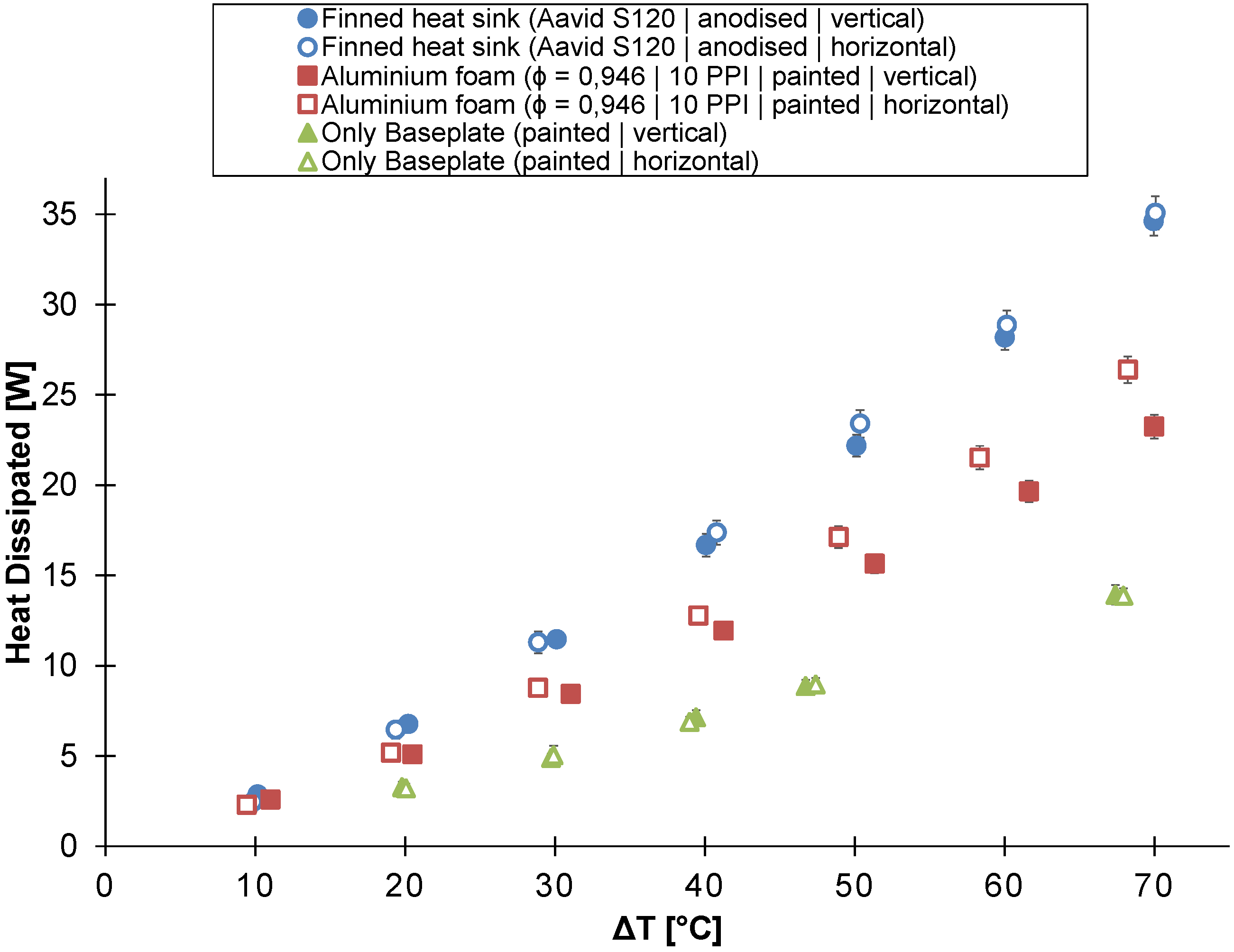

4. Conclusions
- –
- At temperature differences higher than 30 C, significant differences in thermal performance exist between the finned and metal foam heat sinks at the tested conditions. The finned heat sink dissipates on average 17% more heat than the 22 mm-high in-house-manufactured aluminum foam heat sink. The Alveotec® foam heat sink dissipates 12% more heat than the 40 mm-high in-house-made foam heat sink.
- –
- By increasing the emissivity of a heat sink, the power dissipated by a heat sink in buoyancy-induced convection can be significantly increased by up to 50%. The relative attribution of radiative heat transfer to the total heat transfer decreases for all heat sinks with an increasing temperature difference.
- –
- For the tested conditions, metal foam heat sinks dissipate up to 18% more heat in the horizontal orientation.
Acknowledgments
Author Contributions
Conflicts of Interest
References
- Burris, M. Component Failures: How They Fail and How to Identify Failed Components. Available online: http://components.about.com/od/Components/a/Component-Failures.htm (accessed on 30 July 2015).
- U.S. Department of Energy. Building Technologies Program: Solid-State Lighting Technology Fact Sheet. Available online: http://www.webcitation.org/6aKbWerxo (accessed on 30 July 2015).
- Meyaard, D.S.; Shan, Q.; Cho, J.; Fred Schubert, E.; Han, S.H.; Kim, M.H.; Sone, C.; Jae Oh, S.; Kyu Kim, J. Temperature dependent efficiency droop in GaInN light-emitting diodes with different current densities. Appl. Phys. Lett. 2012, 100. [Google Scholar] [CrossRef]
- CREE®; CREE Inc., Durham, NC, USA. Thermal Management of Cree® XLamp® LEDs. Available online: http://www.webcitation.org/6aKchRqUw (accessed on 30 July 2015).
- Kolar, J.; Drofenik, U.; Biela, J.; Heldwein, M.; Ertl, H.; Friedli, T.; Round, S. PWM Converter Power Density Barriers. In Proceedings of the Power Conversion Conference (PCC), Nagoya, Japan, 2–5 April 2007; pp. 9–29.
- Pop, E. Energy dissipation and transport in nanoscale devices. Nano Res. 2010, 3, 147–169. [Google Scholar] [CrossRef]
- Calamas, D.; Baker, J. Behavior of Thermally Radiating Tree-like Fins. Heat Transfer 2013, 135. [Google Scholar] [CrossRef]
- Dogan, M.; Sivrioglu, M.; Yılmaz, O. Numerical analysis of natural convection and radiation heat transfer from various shaped thin fin-arrays placed on a horizontal plate-a conjugate analysis. Energy Convers. Manage. 2014, 77, 78–88. [Google Scholar] [CrossRef]
- Bornoff, R.; Parry, J. An additive design heat sink geometry topology identification and optimisation algorithm. In Proceedings of the 31st Thermal Measurement, Modeling Management Symposium (SEMI-THERM), San Jose, CA, USA, 15–19 March 2015; pp. 303–308.
- De Jaeger, P.; T’Joen, C.; Huisseune, H.; Ameel, B.; de Paepe, M. An experimentally validated and parameterized periodic unit-cell reconstruction of open-cell foams. J. Appl. Phys. 2011, 109. [Google Scholar] [CrossRef]
- Ashby, F. Metal Foams: A Design Guide; Chemical Petrochemical & Process; Butterworth-Heinemann: Oxford, UK, 2000. [Google Scholar]
- Banhart, J. Manufacture, characterisation and application of cellular metals and metal foams. Prog. Mater Sci. 2001, 46, 559–632. [Google Scholar] [CrossRef]
- Dukhan, N. Metal Foams: Fundamentals and Applications; Destech Publications: Lancaster, PA, USA, 2013. [Google Scholar]
- Volz, R. Reticulated Polyurethane Foams and Process for Their Production. U.S. Patent 3,171,820, 2 March 1965. [Google Scholar]
- Jinnapat, A.; Kennedy, A. The Manufacture and Characterisation of Aluminum Foams Made by Investment Casting Using Dissolvable Spherical Sodium Chloride Bead Preforms. Metals 2011, 1. [Google Scholar] [CrossRef]
- Zhao, C. Review on thermal transport in high porosity cellular metal foams with open cells. Int. J. Heat Mass Transfer 2012, 55, 3618–3632. [Google Scholar] [CrossRef]
- Mancin, S.; Zilio, C.; Diani, A.; Rossetto, L. Air forced convection through metal foams: Experimental results and modeling. Int. J. Heat Mass Transfer 2013, 62, 112–123. [Google Scholar] [CrossRef]
- De Schampheleire, S.; de Jaeger, P.; Huisseune, H.; Ameel, B.; T’Joen, C.; de Kerpel, K.; de Paepe, M. Thermal hydraulic performance of 10 PPI aluminum foam as alternative for louvered fins in an HVAC heat exchanger. Appl. Therm. Eng. 2013, 51, 371–382. [Google Scholar] [CrossRef]
- Bhattacharya, A.; Mahajan, R.L. Metal Foam and Finned Metal Foam Heat Sinks for Electronics Cooling in Buoyancy-Induced Convection. J. Electron. Packag. 2005, 128, 259–266. [Google Scholar] [CrossRef]
- Qu, Z.; Wang, T.; Tao, W.; Lu, T. Experimental study of air natural convection on metallic foam-sintered plate. Int. J. Heat Fluid Flow 2012, 38, 126–132. [Google Scholar] [CrossRef]
- De Schampheleire, S.; de Jaeger, P.; Reynders, R.; de Kerpel, K.; Ameel, B.; T’Joen, C.; Huisseune, H.; Lecompte, S.; de Paepe, M. Experimental study of buoyancy-driven flow in open-cell aluminum foam heat sinks. Appl. Therm. Eng. 2013, 59, 30–40. [Google Scholar] [CrossRef]
- De Schampheleire, S.; de Kerpel, K.; de Jaeger, P.; Huisseune, H.; Ameel, B.; de Paepe, M. Buoyancy driven convection in open-cell metal foam using the volume averaging theory. Appl. Therm. Eng. 2015, 79, 225–233. [Google Scholar] [CrossRef]
- Sikka, K.; Torrance, K.; Scholler, C.; Salanova, P. Heat sinks with fluted and wavy plate fins in natural and low-velocity forced convection. IEEE Trans. Compon. Packag. Technol. 2002, 25, 283–292. [Google Scholar] [CrossRef]
- Khor, Y.K.; Hung, Y.M.; Lim, B.K. On the role of radiation view factor in thermal performance of straight-fin heat sinks. Int. Commun. Heat Mass Transfer 2010, 37, 1087–1095. [Google Scholar] [CrossRef]
- Alvéotec; Venissieux, France. Innovation Fonderie. Available online: http://www.alveotec.fr/en/our-news/unique-aluminum-foam-from-goodfellow_41.html (accessed on 24 March 2015).
- Brun, E. De L’Imagerie 3D des Structures a L’Etude des Mecanismes de Transport en Milieux Cellulaires; Institut Universitaire des Systèmes Thermiques Industriels, Aix-Marseille Université: Marseille, France, 2009. [Google Scholar]
- Aavid Thermalloy (Laconia, NH, USA). Available online: http://www.aavid.com/ (accessed on 24 March 2015).
- Taylor, J. An Introduction to Error Analysis: The Study of Uncertainties in Physical Measurements; University Science Books: Dulles, VI, USA, 1997. [Google Scholar]
- Churchill, S.W.; Chu, H.H. Correlating equations for laminar and turbulent free convection from a vertical plate. Int. J. Heat Mass Transfer 1975, 18, 1323–1329. [Google Scholar] [CrossRef]
- Nellis, G.; Klein, S. Heat Transfer; Cambridge University Press: Cambridge, UK, 2012. [Google Scholar]
- Taji, S.; Parishwad, G.; Sane, N. Experimental investigation of heat transfer and flow pattern from heated horizontal rectangular fin array under natural convection. Heat Mass Transfer 2014, 50, 1005–1015. [Google Scholar] [CrossRef]
- De Jaeger, P.; T’Joen, C.; Huisseune, H.; Ameel, B.; de Schampheleire, S.; de Paepe, M. Assessing the influence of four bonding methods on the thermal contact resistance of open-cell aluminum foam. Int. J. Heat Mass Transfer 2012, 55, 6200–6210. [Google Scholar] [CrossRef]
- Fluke®; Everett, WA, USA. Emissivity values of common materials. Available online: http://www.webcitation.org/6aKc191IN (accessed on 30 July 2015).
- Sparrow, E.; Vemuri, S. Orientation effects on natural convection/radiation heat transfer from pin-fin arrays. Int. J. Heat Mass Transfer 1986, 29, 359–368. [Google Scholar] [CrossRef]
© 2015 by the authors; licensee MDPI, Basel, Switzerland. This article is an open access article distributed under the terms and conditions of the Creative Commons by Attribution (CC-BY) license (http://creativecommons.org/licenses/by/4.0/).
Share and Cite
Billiet, M.; De Schampheleire, S.; Huisseune, H.; De Paepe, M. Influence of Orientation and Radiative Heat Transfer on Aluminum Foams in Buoyancy-Induced Convection. Materials 2015, 8, 6792-6805. https://doi.org/10.3390/ma8105340
Billiet M, De Schampheleire S, Huisseune H, De Paepe M. Influence of Orientation and Radiative Heat Transfer on Aluminum Foams in Buoyancy-Induced Convection. Materials. 2015; 8(10):6792-6805. https://doi.org/10.3390/ma8105340
Chicago/Turabian StyleBilliet, Marijn, Sven De Schampheleire, Henk Huisseune, and Michel De Paepe. 2015. "Influence of Orientation and Radiative Heat Transfer on Aluminum Foams in Buoyancy-Induced Convection" Materials 8, no. 10: 6792-6805. https://doi.org/10.3390/ma8105340







